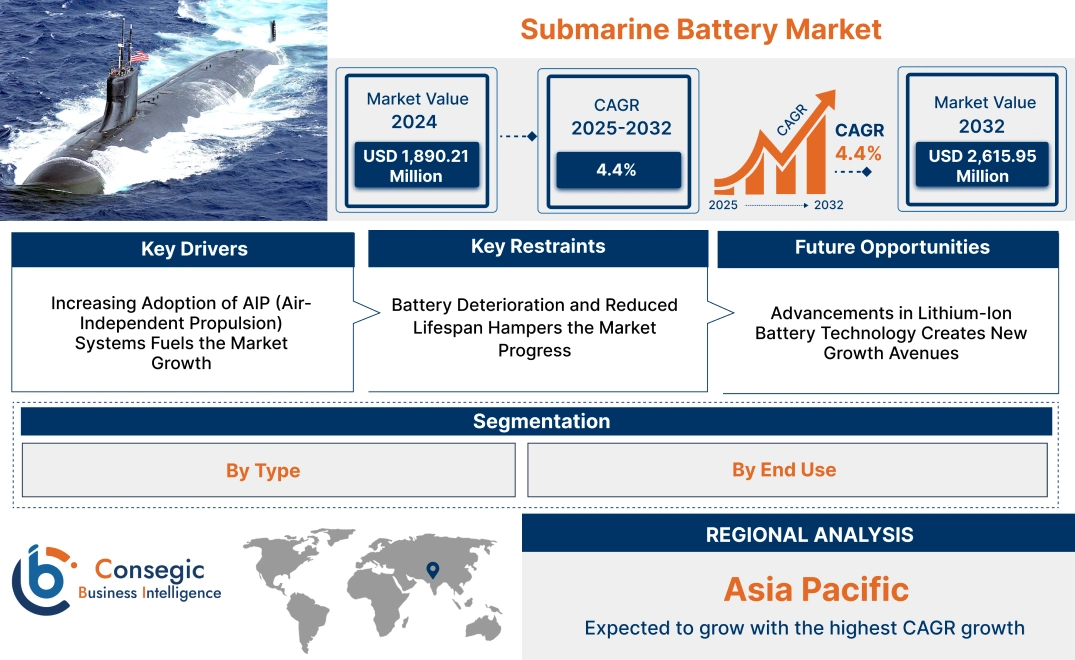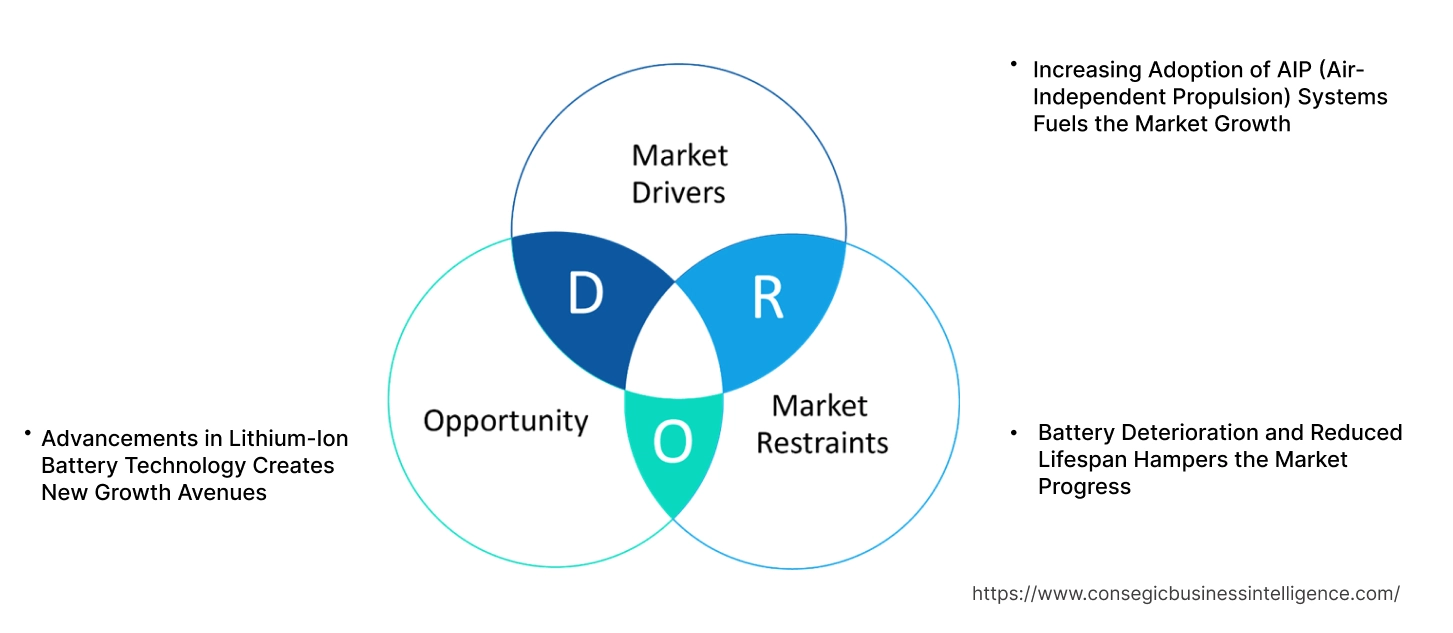- Summary
- Table Of Content
- Methodology
Submarine Battery Market Size:
Submarine Battery Market size is estimated to reach over USD 2,615.95 Million by 2032 from a value of USD 1,890.21 Million in 2024 and is projected to grow by USD 1,935.68 Million in 2025, growing at a CAGR of 4.4% from 2025 to 2032.
Submarine Battery Market Scope & Overview:
The submarine battery market focuses on energy storage solutions specifically designed to power submarines, ensuring their operational efficiency and underwater endurance. These batteries are engineered to provide reliable and long-lasting power in demanding underwater environments, supporting essential functions such as propulsion, navigation, communication, and onboard systems.
These batteries are manufactured using advanced materials and technologies to withstand extreme pressure, temperature variations, and corrosive conditions. They are available in various types, including lead-acid and lithium-ion, catering to specific submarine classes and mission requirements. These batteries are designed for durability, efficiency, and safety, ensuring optimal performance during extended underwater operations.
End-users of these batteries include naval forces and defense contractors involved in building and maintaining submarines for military and research purposes. These batteries play a critical role in enhancing the performance and mission capabilities of submarines across various operational scenarios.
Key Drivers:
Increasing Adoption of AIP (Air-Independent Propulsion) Systems Fuels the Market Growth
The adoption of air-independent propulsion (AIP) systems in submarines is driving demand for advanced battery technologies capable of supporting extended underwater operations. AIP systems enhance the stealth capabilities of non-nuclear submarines by allowing them to operate without surfacing for air, a critical advantage in covert military missions. Efficient batteries, such as lithium-ion variants, play a pivotal role in powering these systems, ensuring reliable energy storage and prolonged endurance.
The shift toward AIP-enabled submarines is particularly pronounced in naval forces aiming to strengthen their defense capabilities while maintaining cost efficiency compared to nuclear-powered counterparts. As AIP technology evolves, the need for high-performance batteries capable of delivering consistent energy output under demanding underwater conditions continues to rise, positioning advanced battery solutions as an integral component of modern submarine fleets. Therefore, the aforementioned factors are driving the submarine battery market growth.
Key Restraints:
Battery Deterioration and Reduced Lifespan Hampers the Market Progress
Submarine batteries face natural deterioration over time due to chemical aging, temperature fluctuations, and repeated charge-discharge cycles. This gradual degradation impacts their energy storage capacity and operational reliability, reducing their effectiveness in critical missions. Factors such as exposure to extreme underwater conditions and prolonged operational demands further accelerate wear and tear.
The need for frequent maintenance or replacement increases operational costs and downtime, posing a significant constraint for naval forces. Additionally, managing the performance decline of aging batteries compromise the efficiency of submarine operations, especially during long-term deployments. This limitation hinders the submarine battery market demand, highlighting the need for continuous advancements in battery durability and lifecycle management.
Future Opportunities :
Advancements in Lithium-Ion Battery Technology Creates New Growth Avenues
Lithium-ion battery technology is evolving to meet the demanding requirements of modern submarines. With higher energy density, these batteries provide extended underwater endurance, allowing submarines to operate stealthily for prolonged periods without surfacing. Faster charging capabilities reduce downtime during critical missions, while extended lifespans lower the frequency of battery replacements, minimizing maintenance needs.
These advancements are particularly valuable for submarines equipped with air-independent propulsion (AIP) systems, as they rely on efficient energy storage for silent and covert operations. Additionally, the compact design of lithium-ion batteries enables greater flexibility in submarine design, optimizing space utilization. As navies worldwide modernize their fleets, the integration of cutting-edge lithium-ion batteries is becoming a strategic priority, presenting substantial submarine battery market opportunities for manufacturers in the market.
Submarine Battery Market Segmental Analysis :
By Type:
Based on type, the market is segmented into lead-acid batteries, lithium-ion batteries, nickel-cadmium batteries, silver-zinc batteries, and others.
The lead-acid batteries segment accounted for the largest revenue of 34.91% of the total submarine battery market share in 2024.
- Lead-acid batteries are preferred for their reliability, cost-effectiveness, and proven performance in underwater operations.
- Their widespread use in diesel-electric submarines is supported by their capacity to deliver consistent power output during submerged operations.
- Ongoing advancements in sealed lead-acid battery technology have further enhanced their operational efficiency and safety.
- As per the submarine battery market analysis, the dominance of this segment is attributed to its long-standing adoption in military and commercial submarine applications.
The lithium-ion batteries segment is expected to grow at the fastest CAGR during the forecast period.
- Lithium-ion batteries are gaining popularity due to their higher energy density and lighter weight compared to traditional battery types.
- Their ability to support extended underwater operations makes them a preferred choice for modern nuclear and autonomous submarines.
- Increasing investments in lithium-ion battery technology to enhance safety and performance drive this segment's rapid expansion.
- As per the submarine battery market trends, the segment's growth is also supported by the shift toward advanced battery solutions for next-generation submarines, reducing maintenance costs.
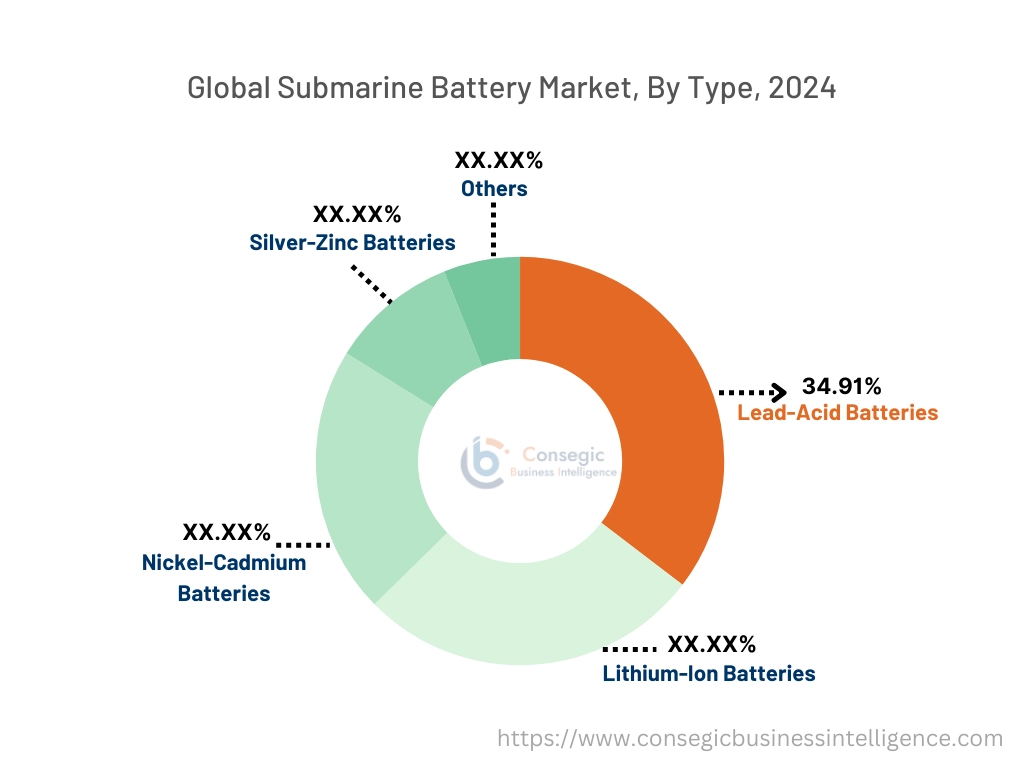
By End-Use:
Based on end-use, the market is segmented into military and civil.
The military segment held the largest revenue of the total submarine battery market share in 2024.
- The growth in focus on naval defense modernization programs has driven the adoption of advanced submarine battery systems.
- Military submarines require robust and high-capacity batteries to power critical operations, including navigation, surveillance, and communication.
- Increasing geopolitical tensions and the need for stealth underwater capabilities have further propelled the adoption of submarine batteries in the military industry.
- As per the segmental trends analysis, the dominance of this segment reflects its critical role in enabling long-term underwater missions and strategic operations, fueling the submarine battery market expansion.
The civil segment is expected to grow at the fastest CAGR during the forecast period.
- Civil applications, including scientific research and deep-sea exploration, are driving the demand for efficient and reliable submarine batteries.
- The growing interest in marine biodiversity studies and offshore resource exploration has created opportunities for advanced battery solutions.
- Technological advancements in lightweight and energy-efficient batteries support the adoption of submarine systems in the civil sector.
- Thus, the analysis of segmental trends depicts that increasing collaboration between research institutions and commercial operators contributes to the segment's expansion.
Regional Analysis:
The regions covered are North America, Europe, Asia Pacific, the Middle East and Africa, and Latin America.
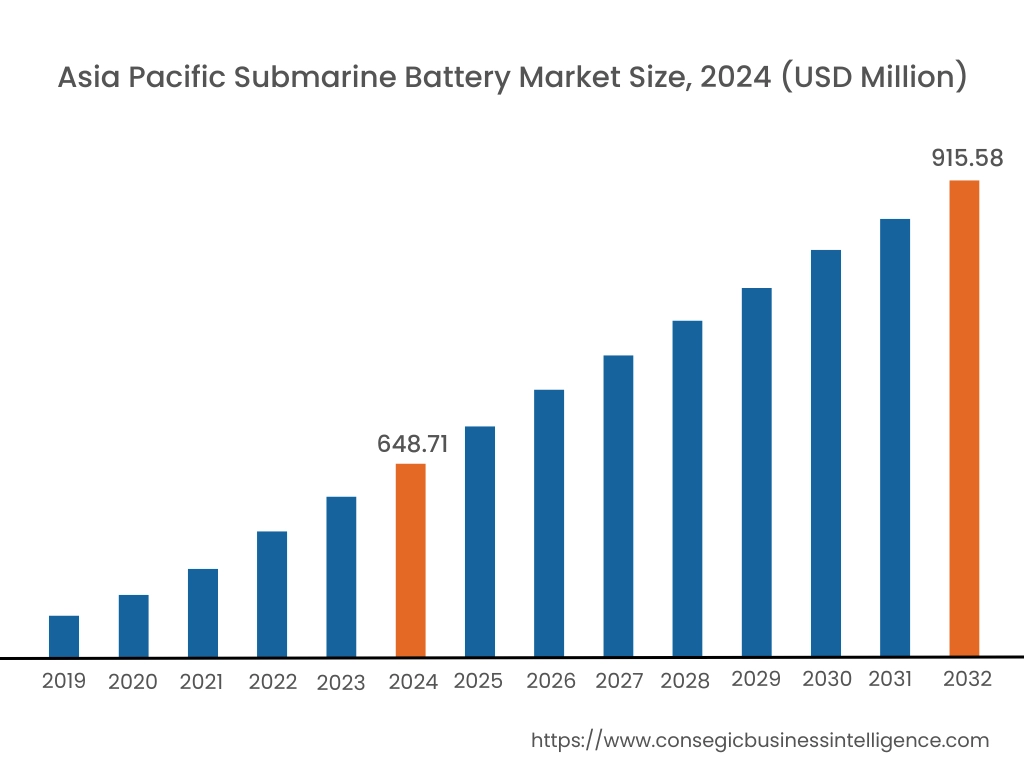
Asia Pacific region was valued at USD 648.71 Million in 2024. Moreover, it is projected to grow by USD 665.41 Million in 2025 and reach over USD 915.58 Million by 2032. Out of this, China accounted for the maximum revenue share of 35.8%. The Asia-Pacific region is experiencing rapid advancements in the submarine battery market, driven by industrial expansion and technological progress in countries such as China, India, and Japan. The proliferation of digital services and the increasing need for scalable IT infrastructure have intensified the adoption of submarine battery solutions. As per the market trends, government initiatives supporting digital economies further influence market growth.
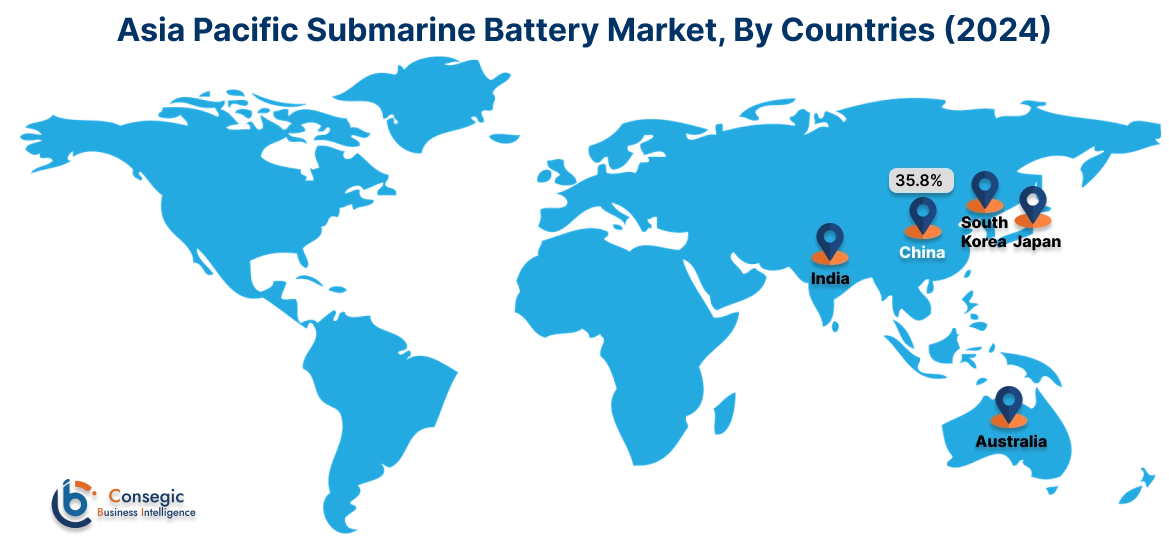
North America is estimated to reach over USD 784.79 Million by 2032 from a value of USD 568.81 Million in 2024 and is projected to grow by USD 582.35 Million in 2025. This region maintains a significant share in the submarine battery industry, primarily due to substantial investments in naval defense and the presence of key industry players. The United States, in particular, emphasizes the modernization of its submarine fleet, incorporating advanced battery technologies to enhance underwater endurance and operational efficiency. A notable trend is the shift towards lithium-ion batteries, which offer higher energy density and longer life cycles compared to traditional lead-acid batteries. Analysis indicates that ongoing research and development efforts, coupled with defense budget allocations, continue to drive the market dynamics in this region.
Europe represents a substantial share of the global submarine battery market, with countries like Germany, France, and the United Kingdom leading in both adoption and innovation. The region's focus on enhancing naval capabilities and ensuring maritime security has led to increased need for advanced submarine batteries. A significant trend is the integration of valve-regulated lead-acid (VRLA) batteries, known for their reliability and safety features.
The Middle East & Africa region is gradually embracing submarine battery technologies, particularly within the defense and oil & gas sectors. As per the market trends, nations like the United Arab Emirates are investing in innovative submarine solutions to enhance service delivery and comply with international standards. Analysis suggests an emerging trend towards adopting advanced battery systems to improve data management efficiency and support digital transformation initiatives.
Latin America is an emerging market for submarine battery technology, with countries such as Brazil and Mexico contributing to its development. The region's focus on modernizing naval infrastructure and improving maritime security has spurred interest in submarine battery solutions. As per the analysis, government policies aimed at enhancing technological capabilities influence submarine battery market growth.
Top Key Players and Market Share Insights:
The Submarine Battery market is highly competitive with major players providing products and services to the national and international markets. Key players are adopting several strategies in research and development (R&D), product innovation, and end-user launches to hold a strong position in the global Submarine Battery market. Key players in the Submarine Battery industry include -
- EnerSys (USA)
- Exide Technologies (USA)
- Akkumulatorenfabrik MOLL GmbH (Germany)
- EverExceed Industrial Co., Ltd. (China)
- Saft Groupe S.A. (France)
- HBL Power Systems Ltd. (India)
- GS Yuasa Corporation (Japan)
- Sunlight Systems (Greece)
- Korea Special Battery Co., Ltd. (South Korea)
- Zibo Torch Energy Co., Ltd. (China)
Submarine Battery Market Report Insights :
| Report Attributes | Report Details |
| Study Timeline | 2019-2032 |
| Market Size in 2032 | USD 2,615.95 Million |
| CAGR (2025-2032) | 4.4% |
| By Type |
|
| By End-Use |
|
| By Region |
|
| Key Players |
|
| North America | U.S. Canada Mexico |
| Europe | U.K. Germany France Spain Italy Russia Benelux Rest of Europe |
| APAC | China South Korea Japan India Australia ASEAN Rest of Asia-Pacific |
| Middle East and Africa | GCC Turkey South Africa Rest of MEA |
| LATAM | Brazil Argentina Chile Rest of LATAM |
| Report Coverage |
|
Key Questions Answered in the Report
What is the size of the Submarine Battery Market? +
The Submarine Battery Market size is estimated to reach over USD 2,615.95 Million by 2032 from a value of USD 1,890.21 Million in 2024 and is projected to grow by USD 1,935.68 Million in 2025, growing at a CAGR of 4.4% from 2025 to 2032.
What are the key segments in the Submarine Battery Market? +
The market is segmented by type (lead-acid batteries, lithium-ion batteries, nickel-cadmium batteries, silver-zinc batteries, others), end-use (military, civil), and region (Asia-Pacific, Europe, North America, Latin America, Middle East & Africa).
Which segment is expected to grow the fastest in the Submarine Battery Market? +
The lithium-ion batteries segment is expected to grow at the fastest CAGR during the forecast period, driven by the technology's higher energy density and extended lifespan compared to traditional battery types.
Who are the major players in the Submarine Battery Market? +
Major players in the Submarine Battery Market include EnerSys (USA), Exide Technologies (USA), HBL Power Systems Ltd. (India), GS Yuasa Corporation (Japan), Sunlight Systems (Greece), Korea Special Battery Co., Ltd. (South Korea), Zibo Torch Energy Co., Ltd. (China), Akkumulatorenfabrik MOLL GmbH (Germany), EverExceed Industrial Co., Ltd. (China), and Saft Groupe S.A. (France).
